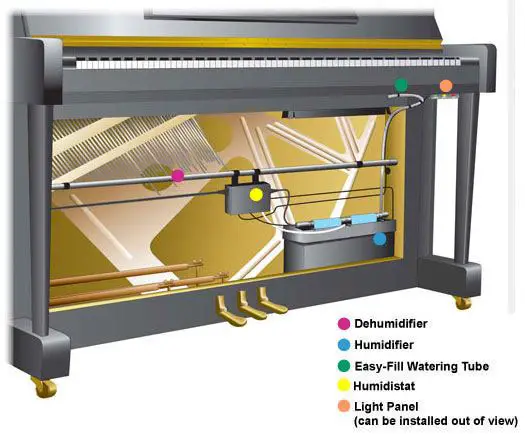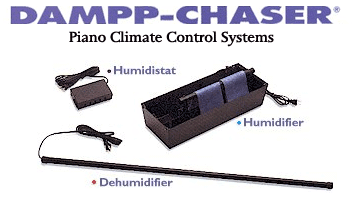
Piano Humidity control is important to protect and maintain your piano. A stable (acoustic) piano is always more enjoyable to play, but for that you need to protect your piano from the extreme or fluctuating humidity levels.Here’s more on how humidity impacts a piano and the various options available to keep your piano in top working condition (maintain proper pitch, and protect the various, tiny wooden parts inside your piano).
Impact of Humidity
Its a known fact that humidity impacts wooden products, and because pianos are made of wood, moisture affects pianos as well.
You can see the effect of humidity on wood even at home. In the winter months the air is drier. As a result, the joints on chairs becoming loose. In summer, because of high humidity, wood doors swell because the wood absorbs moisture from the air.
Similar thing happens to your piano as well.
Seasonal changes in weather and humidity can cause wood to swell and to shrink. In the case of pianos, this phenomenon (of swelling and shrinking) affect three main areas:
- Stability of the Tuning
- Touch of the Keys and Performance of the Piano
- Life of your piano
The metal strings could rust and corrode (when exposed to humidity for a long period), and you may even need to replace the piano strings. Tuning a piano involves stretching the strings, but if the strings are corroded, they may break at the joint, resulting in costly repairs.
This is the reason why acoustic pianos need to be protected against changes in weather and humidity.
Too much humidity can cause the following problems in a piano:
- Keys can stick
- Pitch could be raised sharp
- Touch of the keys can feel sluggish.
Lack of humidity on the other hand can impact your piano more adversely.
- Wood can crack
- Glue joints can become loose
- Your piano could fall flat (requiring more frequent tuning)
Watch: Humidity Control for Your Piano. As mentioned, proper humidification helps reduce seasonal pitch changes and allows a more stable, longer lasting tuning.
How to Control Humidity?
Here are some suggestions that you can incorporate before thinking of buying a humidity control system for your piano (can cost around $500-$600).
- Get a hygrometer to test your piano’s ambient conditions (available for around $20).
- If you already own a heating/cooling system that includes humidity control, make sure its in working condition.
- Excessive dryness can be prevented by using appropriate window coverings (even leafy plants in your room) – or you may buy an in-room humidifier for your piano.
- Excessive moisture can be prevented by keeping windows closed during cloudy or rainy days and – or you may buy an in-room dehumidifier for your piano.
- If these methods fail to produce a more stable environment for your piano, you can consider installing a humidity control system for your piano.
Piano Humidity Control: Maintaining Constant 42% Relative Humidity
You may have heard this from a piano tuner – you need to ensure the piano’s internal environment is consistently maintained at 42% relative humidity, for it to work at its optimum best.
That’s what is the ideal piano humidity level!
However, the wood used in new pianos nowadays is not of extremely high quality (it was different with the older pianos). That is why most piano manufacturers recommend installing a piano humidifier dehumidifier system.
You can avoid humidity related problems and extend the life of your piano by installing a Piano Life Saver System.
How to achieve “42% Relative Humidity”?
You can achieve it by setting up a piano humidity control system (you need to install it within your piano).
Dampp Chaser Piano Life Saver Climate Control System Review
 The Piano Life Saver system by Dampp Chaser is a piano humidity control system, designed to keep your piano in tune and prevent any damage from climate related changes.
The Piano Life Saver system by Dampp Chaser is a piano humidity control system, designed to keep your piano in tune and prevent any damage from climate related changes.
It helps to get professional performance level tonal quality from your piano.
Also known as a “humidifier” and “dehumidifier”, this device (made by Dampp-Chaser Electronics Corporation) automatically maintains humidity levels within your piano at 42-45% relative humidity, year round.
The unit runs silently in the background, stays hidden inside of your piano, and is easy to clean.
Piano Life Saver System is made up of three main parts:
- Humidistat: Senses the moisture in the wooden parts of your piano.
- Dehumidifier: Generates air currents to take away moisture from the piano whenever the humidity level rises.
- Humidifier: Adds moisture to the dry wood in your piano whenever the humidity level decreases.
Dampp Chaser Piano Life Saver Climate Control System Cost
Depending on the number of parts used, the Piano Life Saver can be priced anywhere between $550 to $750.
The various Dampp Chaser accessories and products that you will need to maintain your Dampp Chaser system includes Replacement Humidifier Pads, Replacement Liners, Replacement Clean Sleeves, Other Replacement Items/Parts.
- Dampp-Chaser – Piano Humidifier – Replacement Pads, Liners + Clean Sleeve
- Dampp Chaser Piano Humidifier Pad Treatment Bottle
DIY Piano Humidity Control System
if you’re good with DIY stuff, you can even make your own Piano Humidity Control System.
Here’s how to make an energy-saving Piano Humidity Control System (humidifier / dehumidifier).
Useful Links
Read more piano care tips here. You can also check out some useul piano accessories here.
Related: The Piano Book: Buying & Owning a New or Used Piano
KeytarHQ editorial team includes musicians who write and review products for pianists, keyboardists, guitarists & other musicians. KeytarHQ is the best online resource for information on keyboards, pianos, synths, keytars, guitars and music gear for musicians of all abilities, ages and interests.



Leave a Reply